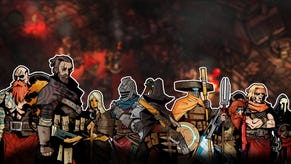Resident Evil 3's Original Devs Are Using the Remake to "Really Build Out Raccoon City"
Producer Peter Fabiano tells us about working with a mixture of new and original developers on the remake, Resistance, and more.
This article first appeared on USgamer, a partner publication of VG247. Some content, such as this article, has been migrated to VG247 for posterity after USgamer's closure - but it has not been edited or further vetted by the VG247 team.
In a month's time we'll all have our hands on a remake of one of the most polarizing Resident Evil games—barely a year after Resident Evil 2 brought the classic survival horror series back to its roots. "We knew that when we were going to take on Resident Evil 2, that we wanted to do Resident Evil 3 as well," says Producer Peter Fabiano.
Fabiano insists Resident Evil 3 is "its own game" rather than a retread of Resident Evil 2's style. After playing a two hour demo of it, it's easy to see both where it's both similar to last year's Resident Evil 2, and where it strongly differs. It all comes down to its pacing and movement, which ebbs closer to an action game than even the original.
Resident Evil 3 is Continuing to Bridge the Gap Into Action
The most notable difference in my demo of Resident Evil 3 is the addition of a dodge mechanic. Your arsenal is the same as it was in Resident Evil 2 remake, at least as far as I can tell, only it combines Leon and Claire's weapon set into one. (Side note: The shotgun only takes up one slot in your inventory now. No longer does it stretch across multiple slots!)
As in the original, hero Jill Valentine can side-step zombies that are trying to make her their lunch. She also has to stay clear of the pesky Nemesis, a hulking, partially-tentacled creature that stalks Jill through her escape from Raccoon City. Nemesis is far more agile than Resident Evil 2's fedora-clad Tyrant, and judging from the demo I played, present in a far more scripted capacity too. Fabiano is coy at whether he'll pop up in a more omnipresent natural manner, like how Tyrant appears at Raccoon Police Department in Resident Evil 2, sticking to the age old, "We don't want to give away any surprises."
"Nemesis is his own brand of horror," says Fabiano. "We had seen what the team was doing with Tyrant on RE2, and the director wanted to make Nemesis his own. You notice when he does show up, it's pretty scary and he's way more nimble. He's quick and he can use weapons, which is something that the Tyrant couldn't. So you'll still have a lot to look forward to with him."
In a section of my demo, Nemesis wields a flame thrower, which makes getting out of his pursuit even more tense. He jumps around unexpectedly, and whips out his tentacles to trip Jill often. With Tyrant in Resident Evil 2, I'd feel petrified hearing his footsteps stomping around the halls of Raccoon Police Department. In Resident Evil 3, I'm the opposite of petrified: I'm instead fueled by adrenaline, like I need to get the hell out of there as soon as possible. Getting away is made simpler though, thanks to the addition of the aforementioned dodge, which was present in the original Resident Evil 3, but not in Resident Evil 2's own suite of weapons and skills.
"With the original Resident Evil 3, you had a dodge mechanic and you'll notice also with the original, when you compare it to Resident Evil 2, it moved more towards action. We wanted to keep in that vein," says Fabiano. Unlike the original (in this humble writer's opinion), the dodge is actually useful now. When I'd hit a so-called perfect dodge, Jill would dodge roll like she was straight out of one of Paul W.S. Anderson's action adaptations and aim immediately after with perfect finesse. Fabiano calls it an evolution of what was started in the original entries, which rolled from survival horror to survival horror-action with Resident Evil 4.

Resident Evil 3 Is Taking More Liberties Than Resident Evil 2 Remake
Resident Evil 3: Nemesis, released back in 1999, has a strange history in the Resident Evil series. It was originally set to be a spin-off of the series because it starred Jill Valentine, while Resident Evil – Code: Veronica was intended to continue the story of Resident Evil 2 star Claire Redfield and Resident Evil 1 hero Chris Redfield. Code: Veronica was developed around the same time as Resident Evil 3 and was a Dreamcast exclusive, unlike RE3.
An excerpt of the book An Itchy, Tasty History of Resident Evil by Alex Aniel, published via Polygon, details how Resident Evil 3 got the numbered name, while Code: Veronica was instead pegged as a spin-off despite starring familiar characters.
"Capcom had always been platform agnostic, and the Dreamcast looked to have at least a year to itself before the PlayStation 2 could arrive," writes Aniel. "The Dreamcast launched in Japan in November 1998, ultimately giving it a 15-month head start. Resident Evil – Code: Veronica was not 'Resident Evil 3' in name, but Capcom's intention was for it to be a proper continuation of the storyline of Resident Evil 2. The reason for going with a subtitle rather than a number essentially came down to console war politics. "The idea was to keep numbered games on Sony and use different names for games made for Sega and Nintendo," [former general manager of Capcom, Yoshiki] Okamoto explained to me in summer 2017."
The new team behind Resident Evil 3, who are once again wielding the RE Engine used for Resident Evil 2 and Resident Evil 7 to bring it to life, is a mixture of original team members, and wholly new people. The original team members working on the remake see it as an opportunity: a big way to expand on the ideas they had and couldn't execute on the primitive original PlayStation hardware. "One thing that really stands out is they were able to really build out Raccoon City a lot more than they would have back then, or could have done back then," says Fabiano.
During my demo, Raccoon City is in all its ruinous splendor. Jill, with handgun and shotgun in hand, steadily traverses the maze-like streets of Raccoon City, with flickering neon signs, zombies clawing at fences, and fires spread out everywhere. It's a city at the peak of chaos, and it's up to Jill to search for supplies in her ultimate goal of restoring power to the train station. In doing so, she makes a detour to the sewers—much like Resident Evil 2's section in the sewers—only it's not in the same spot. The new sewers represent just one example of the remake's new locales. And Capcom didn't just tackle expanding environments, it refocused on characters too.

"We wanted to make Carlos a real partner for [Jill], someone that she could rely on," says Fabiano of Carlos' increased role for the remake. "We took those approaches in terms of how we designed the characters, and when you compare to the original now, we went with photogrammetry and photorealism, and a lot of that comes out when you see Raccoon City, when you see the characters. We wanted to make them feel believable in the space, but we wanted to make them true to the characters that you knew and loved. And then we made some changes as well. For example, like I said, Carlos is [...] more of a rough and tumble type guy, but someone that Jill can really rely on and that she can trust and that can help her throughout her journey."
Like last year's Resident Evil 2, Resident Evil 3 is its own reimagining, Fabiano explains. "We took probably more liberties than we did with Resident Evil 2," he says, "but again, it was very important that we kept to the essence of the original. So we want it to feel fresh but familiar."
The teams behind Resident Evil 2 and Resident Evil 3's remakes ultimately are different, he notes. "With the original, it really had a tight dev schedule, as well as other limitations that they had to deal with in order to make that game. One of the things they did was add the Live Selection to add some replayability," Fabiano says.
Resident Evil 3 had multiple endings that were determined by choices the player makes within cutscenes. Fabiano says Resident Evil 3's remake will instead follow a linear story, and not feature Live Selection nor multiple endings. "With this one, we knew we wanted to tell a consistent story. The director wanted to tell a consistent story. So it made sense to just make it that way and flesh that out and make it feel really tight. And we knew that we had replayability with the Resistance game."
Resident Evil 3 Is More Linear, So Capcom Hopes Resident Evil: Resistance Will Encourage Replayability
With a more "consistent" story, comes less inherent replayability—unless you're a speedrunner. (To that end, Fabiano notes that for a fun additional challenge, "You could try to beat the game with the knife if you'd like.") Considering Resident Evil 2's immense replayability with its slightly differing A and B routes for both Leon and Claire, there was a lot to explore in Resident Evil 2, and that's not even including the Fourth Survivor challenge runs. Resident Evil 3, with just Jill as the hero, doesn't necessitate multiple playthroughs. The area of Raccoon City I played through also felt more linear in how you navigate it than the vast vertical map of Raccoon Police Department. While there were still plenty of puzzles to solve, and safe codes to discover, it was missing that "You have to play this again and again!" magic.

Thus, Resident Evil 3 is bundled with the co-op survival-action game Resident Evil: Resistance, which Capcom hopes is the answer to those cries. In it, characters have their own perks—their own Ultimate abilities. Some are better with melee weapons, while others might be better for tasks like hacking cameras. There is a man named Martin Sandwich, after the "Jill Sandwich" line from the original Resident Evil 3. It's a 4v1 game, with four survivors tasked with solving three puzzles and escaping a place controlled by a villainous "Mastermind"—a.k.a. another player taking on the role of a familiar Resident Evil villain like Alex Wesker, who uses a card deck to summon certain zombies and even familiar boss foes like William Birkin or the Tyrant.
"When we came up with the idea, or when we knew we wanted to build Resident Evil 3, we knew we wanted to have an online component as well," says Fabiano, considering that Resistance was announced long before Resident Evil 3 even was. "So it was always planned to be part of the package."
Fabiano says Capcom has nothing to say on the matter of potential crossovers with Resistance. Previously, Resistance has been described as decisively non-canonical. In the past, Resident Evil has had its own crossovers with other Capcom games like Monster Hunter: World, but as for bringing others into Resistance, mum's the word for now.
Resident Evil 3 and its multiplayer side game Resident Evil: Resistance are releasing on April 3, 2020 for PlayStation 4, Xbox One, and PC. If you're interested in more on Resident Evil 3, we spotted six neat details during our extensive, Nemesis-stuffed demo.










